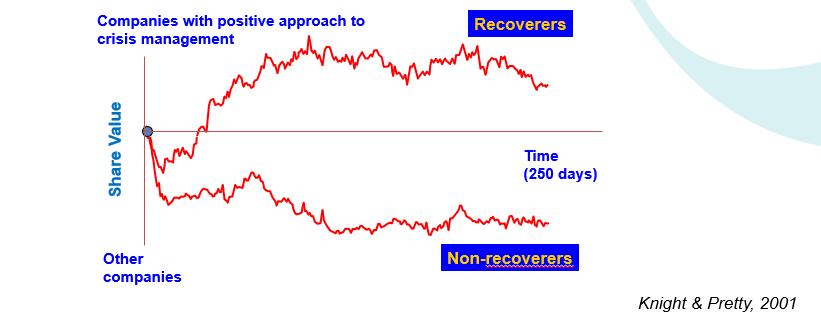This Covid-19 crisis is like no other. It is invisible, pervasive and pernicious. It is wreaking havoc on populations and businesses far and wide, causing fear and anxiety in citizens, corporations and chancellories. While the end game appears distant and the damage colossal, the author Nassam Taleb in his book Antifragile advises that the potential gains from a surprising event can outweigh the losses over the long term.
Although Covid-19 is unique, all crises require strong and clear leadership at many levels. Good leadership can make the difference between success and failure – the true mark of resilience.
This can be seen in some long-standing, academic work carried out by Rory Knight and Deborah Pretty in the early 2000s – see Figure below. They assessed the impact of major corporate catastrophes on the share price of 25 companies. They found that firms appeared to fall into two relatively distinct groups – Recoverers and Non-recoverers. The initial loss of stock value after a crisis was approximately 3% on average for Recoverers and about 12% for Non-recoverers. However, after the fiftieth trading day, the average cumulative impact on stock returns for the Recoverers was 5%. The Non-recoverers remained more or less unchanged between days 5 and 50 but suffered a net negative cumulative impact of over 15% up to one year after the catastrophe.
While the falls in share prices today make these figures look meagre, the factor distinguishing the two groups was the nature of the leadership of the companies involved and their capacity for resilience. The crisis revealed the mettle of the corporate helmsmen and women and their ability to weather the storm, essentially to survive and thrive.
Successful crisis leaders can identify three elements in, or enablers to, making their organisations resilient:
- The means or physical enablers to survive and recover i.e. the resource component.
- The ideas or procedural enablers around which to operationalise a plan i.e. the intellectual component.
- The will or social enablers to create cohesion and motivation among the work force i.e. the moral component.
Cementing together all three elements – in effect, the four element – is communication. Effective crisis leaders in all walks of life are invariably excellent communicators. They convey a clear and succinct core message (i.e. mission orientated), one that is reassuring, collegiate and transparent while also receptive (i.e. a bottom-up appreciation). Only in this way will trust be strengthened so as to convince others that the battle is a collective one.
As many staff are currently working from home then good communications from the top is all the more important through frequent, engaging and meaningful messaging. By so doing, it will be possible to weather the storm.
See also these three relevant articles by John Deverell on our News website:
The ‘prepared mind’ at a time of crisis
Figure: Recoverers v Non-recoverers in crises.

For further reading, please visit our Knowledge Hub.



